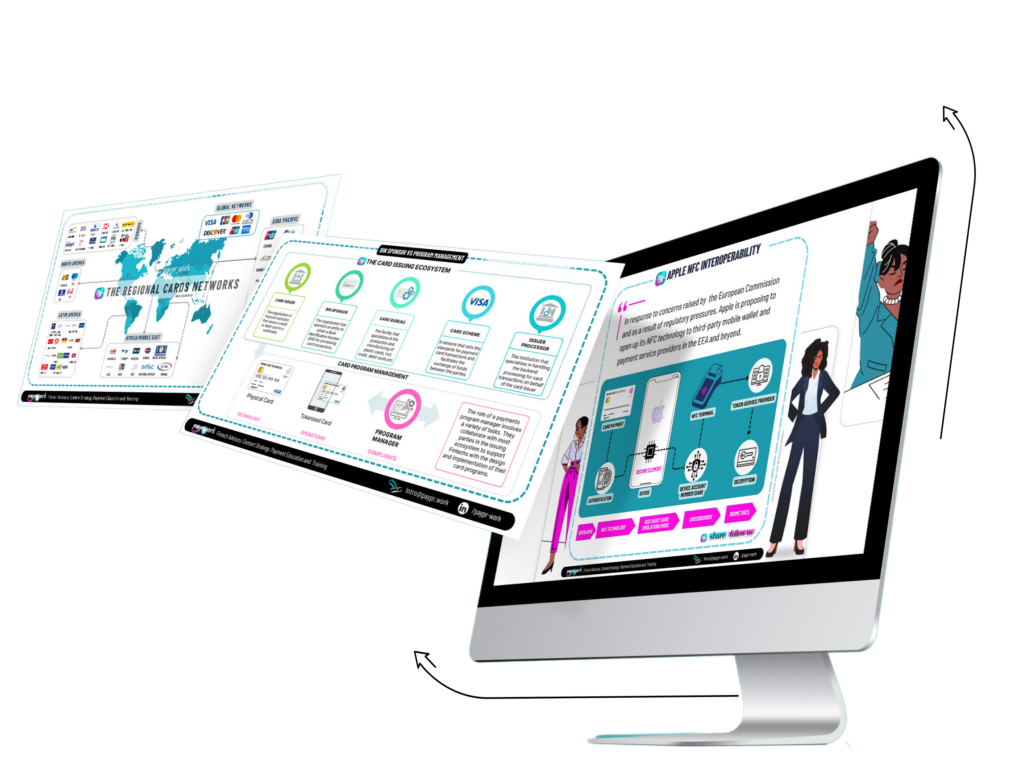To date Paypr.work has produced hundreds of bespoke payments content and visuals. With 40,000+ followers and over 3,000,000 impressions in the last 3 months on our CEO personal Linkedin page and our company pages, we’ve learned the art of storytelling through impactful visuals. We research, write and design focused payments articles and infographics every week.
In this section, you get access to a selection of our blog articles. To unlock our full Payment Premium Resources—which include detailed articles on simple to complex payment topics, a bespoke search matrix to support your learning, and a one-of-a-kind visual library with infographics, reports, payment ecosystem maps, videos, and more—subscribe to our Premium Membership🚀.
If you are already a member, you can access the Member Area through your user menu.


A snapshot of the fundamental concepts behind the processes and technologies that facilitate the transfer of funds between parties, ensuring financial transactions are secure, efficient, and seamless.

Acquirers
Acquirers are licensed institutions that enable a merchant to accept payment card transactions in F2F environment (Customer Present) or virtually/online (Customer Not Present). The channels used to facilitate payments can be card terminals, website, app, email link, virtual terminals etc. Acquirers authorise, process, and settle the transactions through the relevant card schemes, such as Visa and Mastercard. The merchants get a merchant identification account (MID), which enable the acquirer to facilitate the payments through a payment gateway (proprietary or 3rd party).
Issuers
An issuer is an institution that provides cards to businesses or end users (e.g. Barclays, Revolut, Socgen etc). They are a vital connections with the card schemes, such as Visa and Mastercard as their cards get processed through the network rails. They [pre]authorise, approve or decline a transaction.
High Risk >< Low Risk Merchant Account
In order to accept payments irrespective of the channel, a business needs to set up a merchant account (MID) with an acquirer. The process of setting up such an account can vary in simplicity and timescale depending on various parameters. The Payments Services Providers divide merchant accounts into high risk and low risk categories. However, the classification is not as straightforward as it may sound. Some of the criteria that tend to determine the low risk vs high categories are:
Ultimately, a merchant account is a line of credit and therefore, such applications get underwritten by a credit risk team. They typically look at the operational history of a business, the business profitability, assets, reputation, the business senior principals’ credit worthiness and calculate what they deem to be the exposure levels.
This is a measurement of the maximum potential loss they, as the acquirer (aka merchant payment processor), may incur if the merchant defaulted.
The current economic context has certainly driven acquirers to be more risk averse and therefore the opening of a merchant account is more scrutinised than ever before.
Card Scheme and Card Network
The schemes are the payment system (rails) that enable a transaction to be processed through, e.g. Visa, Mastercard, American Express, China Union Pay, Discover and JCB. Any cards issued are always endorsed by a scheme and bear their logo alongside the issuing organisation on the card.
The schemes set the rules and regulations around the use of the cards. The scheme also provides the network which carries the card transactions to the next link in the payments chain. Whenever there’s a transaction, there’s a fee for those in the payments eco-system. The scheme typically get paid either a variable fee of the transaction expressed in % and/or a fixed fee.
Variable fees change according to the card type, acceptance method, and geographic location. Fixed fees may depend on the card scheme services used and the volume processed. Visa, MasterCard, American Express and Discover are among the largest global card schemes.
Typically local acquiring is key as it significantly impacts payment approval rates and profitability. In some markets, it’s nearly impossible to convert consumers without processing on the local rails. Certain issuers treat authorisations from other countries differently, based on that country’s global risk ratings, irrespective of the bank or merchant. Interchange, scheme and processing fees are often more expensive with cross-border transactions.
Working with a single global payment partner is more an utopia than a reality as typically acquirer will require local acquiring licenses or processing capability in each of the targeted countries. The reality is that most aggregate or ride on the back of other local 3rd party.
Blended >< Interchange Pricing
All payments card processing are typically made up of three components:
Acquiring fee: this is mark-up the acquirer apply for the provision of their card processing services (auth, acquiring, settlement).
Card scheme fees: This is the fee the scheme charges for providing the network rails through which cards are processed. These fees can be expressed as % or flat rate for using its network.
Interchange fee: This fee is set by the schemes and is paid to the cardholder’s issuing bank (issuer). Interchange fees make up the most significant chunk of the card processing fees.
The Interchange fees and are non-negotiable and are also regularly adjusted (e.g. V/M review their rates in April and October every year).
When these three items are combined into one charge, it is often referred to as an [un]blended pricing. It is a simplified pricing model with the rates expressed as a % (e.g. 1% debit cards, 2% credit cards). It is an easier model to understand.
Interchange++ is a transparent pricing structure, whereby the acquirer only quote their mark-up and pass through the other two component to the merchants. The merchants therefore get a detailed breakdown of the three payment card costs and can benefit from a fee reduction where the interchange fees are reduced, as these fees are simply passed through.
Blended pricing models are most widely used in smaller, mid tier merchants whilst large account tend to be on the IC++ model (i.e. Interchange Plus Plus).
APMs >< Open Banking
Alternative Payment Methods (APMs) used to mean anything that wasn’t cash or a credit card.
Now it’s used to mean anything that doesn’t use traditional payments infrastructure, specifically, card companies like Visa and MasterCard.
The EU’s PSD2 legislation that came into effect in 2018 has a lot to account for the flood of innovation erupting in payments over the years. Newer payment methods reflect the changing reality of consumers behaviours that are choosing to shop more online and via a mobile device.
PSD2 was designed to boost competition in financial services and modernise the payments infrastructure. This involves a new kind of payments company, able to provide A2A (account-to-account) transactions throughout Europe.
Open banking enable users to grant permission to third parties to access their financial information.
Companies that create application programming interfaces (APIs) are able to provide innovative financial services via technology without first needing to have a physical presence like high street banks.
Payment Information Service Providers (PISPs) access consumer and business bank accounts directly via the banks’ APIs. This lets them move money directly between accounts, without any other intermediary.
Comparing Open Banking with card payments, card transactions pass through a chain of several companies. This typically includes a payments gateway, acquirer and processor, as well as a card scheme and the customer’s bank. Card transactions take several days to settle and incur fees from each intermediary, eating into the merchant’s margins.
Open banking is a very hot topic. Until now, account-to-account payments had only been a viable alternative to cards in some countries, like the Netherlands, where the iDEAL systems had been leading there for years.

Paypr.work blends payment knowledge and custom research into a simplified yet insightful narration. Our narratives feature visually engaging designs that break down both fundamental and complex payment jargons into bite-sized, repetitive micro-concepts to promote better comprehension and retention.
Sign up for a Paypr.work Premium Membership to exclusively access all of our payment resources, including our full articles, industry insights, ecosystem maps, reports, videos, and our unique library of bespoke infographics.
Don’t miss out— sign up to learn payments in a captivating way!



You have provided so much light and knowledge in a fascinating world. You definitely bring the fun to Fintech like no one else and actually know what you are talking about! Thanks goodness for you😁!

Vice President Global Product Expansion, Shift4
Impressive, congratulations Sandra and Team Paypr.work. The detail in each of your 100+ infographics is outstanding and showcases your expertise well… Continued success for this remarkable work!

LinkedIn Strategist | Digital Transformation Leader

Host of Heads Talk
Your diagrams have the ability to explain the most complicated of topics in way that can be understood by anyone. Not many people have the ability to create self-explanatory visuals, so keep doing your magic 🔥🔥🔥!

CEO & Co Founder of CLOWD9
Your content is so informative, accurate, and fabulously presented in infographics that always attract great attention. Your visuals naturally spark strong engagement regardless of the LinkedIn algorithms !

B2B Marketing, Marqeta
The depth of Paypr.work knowledge and skill sets are truly impressive. Their ability to combine deep industry expertise with well-depicted visual is pretty unique. I strongly recommend Sandra and Paypr.work !

Director EMEA Payment Solutions, Marriott International
👏👏 👏👏 👏👏 I always love your content and in fact, I am so happy for all of us in the industry… we’re lucky to have you sharing your payment wisdom with us 🤓… thank you! Keep up the great work.

Strategic Accounts Director, Truelayer | Payments and Fintech Geek
Merci Sandra pour ta facilité à vulgariser le paiement via de simples dessins, qui me surprendront toujours. Pour ceux qui ne connaissent pas son travail, je vous invite à suivre Paypr.work [ˈpeɪpəwəːk]!

Product Manager Paiement, Maisons du Monde
Your enthusiasm and ability to simplify Payments is so refreshing and literally shines through! Sandra and her team research, write content and create some stunning infographics for the payments industry….

Chief Operations Officer, Clowd9
Keep up the good work and know that your hard work and dedication is so inspiring for all of us. You are truly doing an incredible job and your consistent efforts don’t go unnoticed.

Chief Community Officer, NORBr | Redefining Payment Infrastructure | Linkedin Top Voice
Your posts are a masterclass in how payments have evolved from a basic utility to a strategic asset. Your ability to simplify this complexity and provide strategic direction along with implementation support is so invaluable. The clarity and depth you provide are exactly what this fast-evolving industry needs.

Chief Commercial and Operations Officer, Soffid
The mechanics of all things payment are a black box for most industry stakeholders. With the help of their well researched and designed infographics, Sandra and her team at Papr.work demystify complex flows and create awareness about the factors that play a role in the end to end processes.

Paul van Alfen | Managing Director Managing, Up in the Air - Travel Payment Consultancy
Your Paypr.work subscription gets you full access to all Paypr.work content in 1 place including: our weekly new payments articles, our infographic blog, exclusive discounts on all the services that Paypr.work has to offer and the opportunity to collaborate on free infographic to promote your knowledge/value proposition and more. The content is for personal use and cannot be copied, reproduced, redistributed, altered, modified, shared publicly or with third-party nor can derivatives of the work be created. The user may share content that is available through the free blog access subject to crediting Paypr.work with the attributions.